Exponent II's Blog, page 128
November 16, 2021
I Don’t Like the Temple. I’d Appreciate It if the Church Would Stop Gaslighting Me About It.
 Photo by Joshua Hoehne on Unsplash
Photo by Joshua Hoehne on UnsplashThe morning after I received my endowment in the temple, I woke up sweaty from the double layers of my new garments and nightgown. Memories from the night before floated to the surface of my murky consciousness: the hours I’d spent in the beautiful white building and all of the panic I’d felt leading up to the experience dulled by numbness once the day finally arrived. But that survival mechanism had switched off overnight, and something inside me fractured, and I felt my previous panic turn into despair, and I curled up in the large chair in my parents’ bedroom and cried.
I was inconsolable for hours. My memory consists more of emotional impressions than a hard timeline, but I remember my mom seeing my anguish, talking to me for a few minutes and giving me the equivalent of a brief “there, there” before she had to leave. I remember she was kind, but she did not validate what I was feeling. My pain was a physical thing, a hard shape varnished with shame.
I’d been as prepared for my endowment as I could possibly be: I’d read Boyd Packer’s The Holy Temple (spoiler alert: it contains no spoilers or anything remotely informative for novitiates), taken two temple prep classes, studied through the Pearl of Great Price twice on the advice of my dad, fasted and prayed, and consulted with leaders and my parents about my extreme anxiety around going through the temple (what if everything I’ve ever believed in is a lie? What if, after the temple, I can never look at my parents or loved ones in the same way again?). If I could have gone on my mission without going through the temple, I would have, but that wasn’t an option, so I threw myself into doing everything I could to ensure it would be a positive experience.
I made it through the ordinances and the ice cream with extended family afterward without any major hiccups. The experience wasn’t great, but it wasn’t terrible, either. The morning after, though, I was filled with spiritual malaise. The misogynistic aspects of the ceremony had disturbed me, but since I wasn’t getting married, I felt like those parts didn’t apply to me, and it was easy to wave them away.
I went into the temple confident that Heavenly Father knew me and loved me. My relationship with God felt personal and intimate and comfortable. But the God represented in the endowment was not the Father I knew. This God was aloof, removed from me by a two step, two way relay system of male messengers. This God required secret passwords given to third parties before I was allowed to be in his presence. The God of the endowment was not a loving father; he was a bureaucratic CEO. It was a profoundly devastating bait and switch.
I forced myself to go back to the temple again and again, trying to find enlightenment and peace. Some sessions, I literally shook with anger. Some, I cried in frustration or despair. Some, I sat through numb and bored. Occasionally, I felt a glimmer of what I’d been taught the temple was supposed to be like, but it was rare and small. It took a decade for me to realize that the temple just wasn’t my spiritual language. God came to me in music, in writing, in nature. Not liking the temple didn’t mean there was something wrong with me.
In Church talks, manuals and culture, the temple is only ever presented in a positive light. Experiences like mine are never represented, not even when they have a “faith promoting” ending (i.e. “Sister X used to struggle with the temple, but she has since gained a testimony of it and now loves attending!”). I felt embarrassed, like I was an anomaly, like the fault was mine, like if I just tried harder I would find peace and inspiration in the temple like everyone else. Every strong exhortation and tender anecdote in General Conference about the peace and blessings found in the temple added another layer to my shame.
Nothing has made me question my worth or my sanity more than institutional gaslighting from the Church, whether about sex, the temple, gender roles, valid reasons to stop attending church, or patriarchy. When key parts of my lived experience were not only not validated but never acknowledged at all, I felt aberrant and alone.
I started tentatively speaking up about my experience with the temple in small ways, slipping admissions into conversations with friends, comments in church lessons, or my own sacrament meeting talks. “It’s not really my thing,” I’d say; or, “I really used to struggle with the temple.” And every single time I did, someone would seek me out afterward. “I thought I was the only one,” they’d say, intense relief apparent in their voice. “That was my experience, too.”
Pretending that things don’t exist outside of the prescribed narrative makes those whose lived experience contradicts that narrative feel broken and ashamed, but the gospel of Jesus Christ draws a circle wide enough to hold the whole of us, contradictory and conforming parts alike.
November 15, 2021
How Well Are Women Actually Represented on Latter-day Saint Women pages? (Spoiler: Really Terribly!)
There’s a popular Facebook page called “Latter-day Saint Women Stand” (formerly “Mormon Women Stand”) with over 55,000 followers. This page regularly posts faith related content and updates on the LDS church, and a number of my friends online follow and enjoy this page. Recently one of those friends shared a post from this page, and I clicked over to check it out.
I’ve been doing a new experiment lately where I look at any church related sites and posts and pretend to be an outsider. (A couple months ago I first did this with my own ward Relief Society Facebook page and wrote about it HERE.) What would this look like to me if I hadn’t spent a lifetime in the church and Utah? Would it look normal, or would something seem strange? Well, something definitely seemed strange when I went to this popular LDS women’s page – there are almost no women quoted or pictured as I scrolled through the recent posts. I scrolled through sixteen (16!) posts with photos and quotes by male leaders before I found the first one about a woman. I scrolled through eight more male posts and found the second woman (now out of 24 posts).
And it just keeps going, and going, and going…the number of posts that are given to women’s voices compared to men’s voices is abysmal. I can’t imagine what this looks like to an outsider investigating the church. If I were investigating the Catholic church and went to a Catholic women’s page and found only information about men, I’d be confused. If I went to a Presbyterian women’s Facebook page and scrolled for ten minutes and found only three posts by Presbyterian women, I’d think they mislabeled their page accidentally. If I went to a Methodist women’s Facebook page and found man after man after man featured, I’d probably think the Methodists were nuts.
But in my own church, it’s so normal and commonplace that nobody running this page (or the 55,000 people following it) seems to recognize it as a problem (or that it’s even something out of the ordinary).
The day that I noticed this I took screenshots of the most recent posts, which I have now marked with either a blue checkmark if it’s a post about a male leader, or a pink checkmark if it’s a post about a female leader. You can see that it heavily skews towards the blue checkmarks:

I pulled up another popular Facebook page with over 25,000 followers called “Latter-day Saint Women”, and found a nearly identical pattern:

What if it was reversed? What if there was a Latter-day Saint Priesthood Holder Facebook page, and over 90 percent of the posts were from Relief Society presidents or Primary presidents? Would anyone NOT notice that was odd?
I’ve also recently moved into a new house and a new ward. To be clear, I’ve received nothing but kindness from friendly ward members and they are absolutely free to post whatever they want on their personal social media pages with whoever’s words resonate with them most (male or female).
However, two very nice members of my new Relief Society presidency stopped by to visit me and welcome me to the neighborhood after church one day. I sent them both a friend request on Facebook afterwards and was happy to have met them. What was interesting to me was a quick glance at what these two top female leaders in my ward (which is a very large ward of over 800 people) choose to post on their personal walls. They both quite frequently share LDS quotes and messages, and the vast, vast majority of those are from male leaders, not female.
It took scrolling back a full year (and past 28 re-posts of male church leader or scriptural quotes) to find the first reference to a woman on my new Relief Society president’s Facebook wall. (Is this possibly a character trait of the women that bishops are most likely to choose as Relief Society presidents – women who really enjoy repeating the words of their priesthood leaders?)
I did find a few more LDS women referenced on her counselor’s page, although it was still heavily male. In the most recent forty religious posts (like the president, she posts a lot of them!), seven of them were from women.
I wish ward Relief Society presidents as a whole would begin to expand the influence of women by sharing more quotes and inspiration from female leaders, authors and artists in the church. I would feel much more comfortable inviting female friends outside of the church to a women’s organization that valued and promoted the words of other women, but it feels like no one – not ward Relief Society Facebook groups, not public social media pages geared towards LDS women, and now not even my new ward’s Relief Society presidency (on their own personal walls) feel odd about promoting almost exclusively male viewpoints and advice. One would think that in a women’s organization the gender imbalance would skew to the female, but it almost never does – and almost no one seems to notice.
Is this any surprise? For years we studied “Teachings of the Prophets” in Relief Society. I never heard anyone ask for “Teachings of General Relief Society Presidents” next to balance that out. We regularly cover general conference talks in Sacrament Meeting talks and lesson plans, which are by men the vast majority of the time, and we depend on patriarchal blessings to guide our decisions in life with no comparable revelation from a wise older woman in our stake. The only reason we don’t recognize how weird and lopsided this has been is because most of us have never seen it play out any other way.
Finally, to end on a positive note – I did find one Latter-day Saint Facebook page that is doing it right. It’s called “The LDS Women Project”. Look at all the pink checkmarks, and do your best to make the rest of your world look more like this one: 
(And of course, keep following The Exponent blog and subscribe to the magazine, because we produce phenomenal female oriented content all the time!)
November 14, 2021
Guest Post: Why Heavenly Mother is Essential: Part 4
Guest Post by McArthur Krishna, McArthur comes from a pack of storytellers. And while the pack rightly insists she’s only in the running for third-best storyteller on a good day, she’s made her living in stories. Stories in words and visual art that inspire, demand, encourage and cajole us along this wild ride of life. If you know her, she will unabashedly tell your stories too (with some degree of truthiness). Look out.
This is the fourth of a seven-part series about why Heavenly Mother is essential.
Interpretations of the garden scene and Eve’s role in Genesis have done a lot of damage to the value of women. Trust me, it makes me grouchy. However, as LDS women, not only do we have a different interpretation of that event (one obviously more ennobling), we also can insert the wonder of Heavenly Mother into that scene. How that impacts us and the world can be extremely powerful.
Essential Fact #4: Women are made in the image of Heavenly MotherThe Hebrew term Elohim is plural— and so when we read in Genesis that we are made in God’s image, the correct grammar is actually “Gods’ image”. Elohim does not always mean Heavenly Mother and Heavenly Father but due to the gender of the verbs, it indicates male and female plural in this instance. And, we have prophetic testimony: according to President Kimball, “You are daughters of God… you are made in the image of our Heavenly Mother” (Conference Report, Mexico City and Central America Area Conference 1973).
I am made in the image of my Mother in Heaven.
How does that change how we think of ourselves?
In the last few years I have been forced to think about what Heavenly Mother looks like: what her body looks like and how she is represented. When Bethany and I wrote “A Girls Guide to Heavenly Mother” and “A Boys Guide to Heavenly Mother” we intentionally recruited artists from around the world. In my immediate family we have Hawaiians, Blackfoot Indians, Haitian blacks, Far East Indians, and combinations of those! I was very very clear that I would not put out a book that canonized Heavenly Mother as one ethnicity or even one culture. We had artists from Cambodia, Nigeria, South Africa, Lebanon, Qatar, Argentina and more. We had art that depicted a Native American, Polynesian, Latina, and Black Heavenly Mother. We stretched out as far as we could to be as visually expansive as possible.

Kwani Povi Winder, “Welcome Home”
In one year, there will have been three art shows on Heavenly Mother. We hosted one with the artists from our books in May 2021, Certain Women Art Show is happening now (SLC at Anthony’s until Nov 13, 2021) and the LDS Center for the Arts is hosting one starting in January 2022. The LDS art on Heavenly Mother has gone from a few pieces to literally hundreds. Check IG #heavenlymother for just some of them.
This both blows my mind and makes me want to stand and do a jig.
Why does this matter?
Because what we take in informs how we see ourselves and how we see the world.

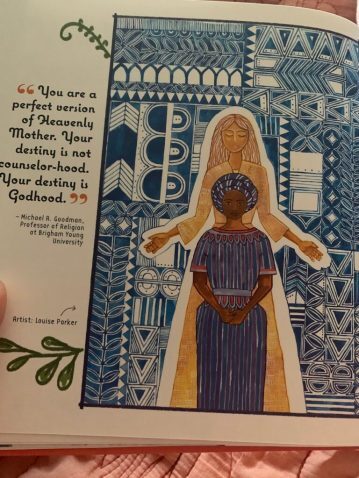 Louise Parker
Louise ParkerMy youngest daughter flipped through the “Girls Guide to Heavenly Mother” She told me she was not interested in the words— but the art captivated her! She spent hours poring over the piece and then came and showed me this. She had drawn her vision of many of the pieces in the book: the images were burned in her brain. And my heart sang. My girl knows she is a daughter of a loving Heavenly Mother.
Our guide books started because Bethany’s oldest daughter had hit tween years and had some bold and normal questions about her body and how it works and how it’s valued. I had conversations with my older daughters about where your nexus of worth was— rooted inside yourself or externally swayed. Our daughters needed to know where to root themselves and their body image, and there is no better place than Heavenly Mother.
As my co-author says, “When I think of a goddess, I don’t think of small or diminished. I think in grand scale— magnificent, voluptuous, expansive.”
Knowing that Heavenly Mother has a body isn’t just about our identity and our eternal destiny, it’s also about how we treat ourselves. This is new for me. I have spent most of my life paying extremely little attention to my body and having it do almost exactly what I want it to do. I have always been strong enough and healthy enough to move, lift, dance, boat. In fact, my husband told me that I had become infamous with men working on our farm in India because, “Madame just picks something up and moves it.” Yes, high bar.
And then, three things decimated me: covid, perimenopause, and falling down the stairs and ripping some muscles that put me in PT for almost a year.
All of a sudden the body I had completely taken for granted was not an instrument of power, but an absolute hindrance. I was ill-suited for taking care of it. Food is a bother, I’m an insomniac, and exercise is, well, not my favorite.
However, I am living my way into this. I am trying to see that for all of my passion about the importance of Heavenly Mother, I need to honor that body that is like Hers. I need to honor the gift.
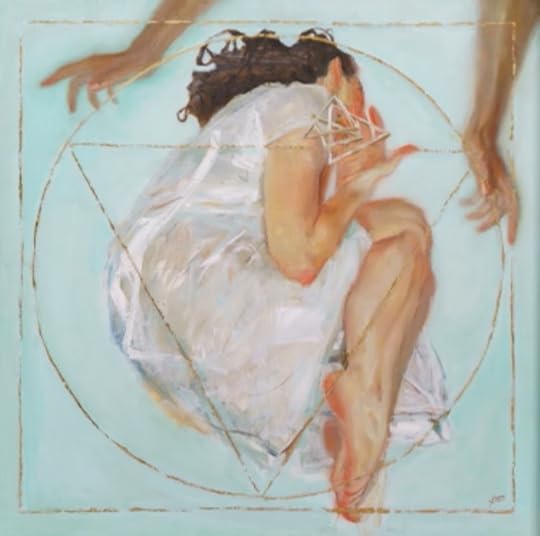 Jenna Conlin, “In Her Midst”
Jenna Conlin, “In Her Midst”Where my co-author lives, she is involved in food justice programs and another NGO that helps girls get healthy. A study found that girls became uncomfortable with their body, quit moving, adopted harmful body image issues and the results are a very diminished quality of life not just for teenage years but all the years we live this life. Quality of earth life matters!
I do know that I want to be a source for light, and that includes my physical form. When I get enough sleep, when I eat well, when I move my body, I am also honoring my Mother in Heaven.
With that idea of light, I want to leave you with one story I read in my research. I apologize, I can’t find the source. It is not LDS, but the beauty of it struck me.
May we remember we can be beings and bodies that are “waves of light”… like our Mother.
“Shekhinah” is Mother in Heaven.
[Rabbi Abraham] walked through the streets of [his home town] Safed, crying out “Arise, for the Shekhina is in exile….” He longed, more than anything else, to bring back the Shekhinah out of exile.,,, [Advised to go to the Wailing Wall, after fasting, he set off on foot.] With every step he took, he prayed God to reveal … a vision of the Shekhina to him. By the time Rabbi Abraham reached Jerusalem, he felt as if he were floating, as if he had ascended from his body. And when he reached the Wailing Wall, Rabbi Abraham had a vision there. Out of the wall came an old woman, dressed in black, deep in mourning. And when he looked into her eyes, he became possessed of a grief as deep as the ocean, far greater than he had ever known. It was the grief of a mother who has lost a child; the grief of Hannah, after losing her seven sons; the grief of the Shekhinah over the suffering of Her children…. At that moment Rabbi Abraham fell to the ground in a faint, and he had another vision. In this vision, he saw the Shekhinah once more, but this time he saw Her dressed in Her robe woven out of light, more magnificent than the setting sun, and Her joyful countenance was revealed. Waves of light arose from her face, an aura that seemed to reach out and surround him, as if he were cradled in the arms of the Sabbath Queen. “Do not grieve so, My son Abraham,’ She said. “Know that My exile will come to an end, and My inheritance will not go to waste.’
November 12, 2021
The Covenant Path
I was asked to speak in Stake Conference on the topic “Staying on/Returning to the Covenant Path.” This was my talk. (Note: The meeting was on Halloween, hence the sweater. At least I can be confident I brought the Spirit with me).
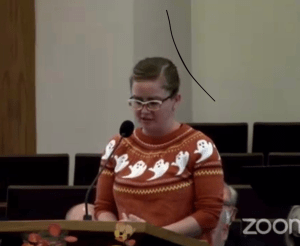 For the first quarter century of my life, staying on the covenant path was not particularly tricky. I got baptized right on time, finished my Young Women’s medallions, took out my endowment, went on a mission and was sealed in the Temple at 25. Done and done. I liked going to the Temple and went as often as I could.
For the first quarter century of my life, staying on the covenant path was not particularly tricky. I got baptized right on time, finished my Young Women’s medallions, took out my endowment, went on a mission and was sealed in the Temple at 25. Done and done. I liked going to the Temple and went as often as I could.
And then, almost without me really noticing it happening, something changed. I first started noticing the real gender disparities within the Church when I served a mission. I had naively thought that the way I felt secondary in the YSA ward was because I hadn’t served a mission and wasn’t as wise as all those mature 22 year old young men who knew the scriptures so well. I thought that being a missionary would automatically put me on equal footing. I remember in the MTC our teacher presenting an investigator’s concern from her missionary days, and asking us to resolve it. My district leader said “maybe she just needs to hear the Gospel from a man.” I will tell you right now that my urge to slap him was so strong I had to leave the room, sit on my hand, and cry until the fury subsided. It was not an isolated incident.
After my mission I started a graduate program in history. I focused on gender theory and Modern France. I started to see the world in an entirely different way, noticing things that I had never noticed before, and that could not be unseen once I did. It grated, and grated, and grated on me. When I brought up my concerns mostly people said “I guess I never noticed that” and it seemed like I was the only person in the Church who had ever been bothered by those things. But I wasn’t. The internet was full of people who understood exactly how I felt and exactly what I was thinking. For awhile that made me feel better – less alone, less crazy.
But then it started to make me feel worse. I wasn’t trying to find new flaws in the Church. I wasn’t looking to feel angrier, I just wanted to feel seen and validated in my own struggles. But increasingly the blogs and chats that I frequented were places where no one was staying in the Church. They were full of rants about people in other wards and other states – they made me furious, but over what? People I would never meet and who had no authority over me. Reading started to make me feel worse. But Church still wasn’t making me feel any better.
I didn’t know what to do. As a Young Woman I had been taught the value of integrity. On one hand, I knew the testimony I had received and I felt that I could not deny it and retain my integrity. On the other hand, I didn’t feel like I could just pretend my concerns away as if they didn’t exist. I care about gender equality, and racial equality, and the rights of LGBTQ people. So how could I stay in an organization like the Church? But I also love the Savior and feel this is the place to be, so how could I leave? This kind of cognitive dissonance – trying to believe two mutually exclusive things to be true — is really painful, and our brains don’t like it. We yearn for resolution, and I know that many of my friends were only able to feel peace again by walking away.
The answer I received is not one that I am promoting to everyone. I feel that it was the answer God gave to me. If you find yourself in a similar miserable quandary, then I suggest you seek your own answer of if and how you can stay. My answer was this: The Church is true in the Eugene Fifth Ward. Hold on to the pieces that allow you to stay. Distance yourself from anything that is making it hard to want to stay.
So I did. I stopped reading the blogs I was reading, and I left the social media groups I had frequented. I also unsubscribed from Church magazines, I stopped watching General Conference, I didn’t read anything that came from the Church News Room and I didn’t visit any Church websites. I stopped attending the Temple, because that had become excruciatingly painful. Most of my pain and conflict was coming from policies, not doctrine. The doctrines were all right there in the scriptures in my house. The application of doctrine was right before me in my home and neighborhood. If the corporate aspect of the Church was too hard to take, then avoid it as much as possible. Do what you have to do to stay.
As I said, I am not advocating for this as some universal policy. I’m telling you what worked for me. And I think there is a sound doctrinal reason for that answer, despite how unorthodox it sounds. Humans are temporal creatures. Our only time and place to act is here and now. The scriptures warn against looking beyond the mark, lest we stumble. I think we’re tempted to place our obedience to commandments in the land of make-believe without ever realizing it. We speak of being willing to live the law of Consecration as practiced by the pioneers, but that is some hypothetical future willingness, not a here-and-now sacrifice. As a teenager I was constantly taught to plan now what I would do in hypothetical tempting situations, so I would be prepared. And I did. But I was never offered any alcohol or drugs, because I was not cool, and was not invited to parties. I never had a boyfriend – all the Mormon boys at my high school were either three years older or two years younger, and in any case I was much more interested in romantic book heroes than real human guys. I was drawing pictures of princesses and watching musicals with my best friend right on through graduation. All that hypothetical obedience to the Word of Wisdom or the Law of Chastity turned out to be rather less important that the challenges that were right in front of me.
The Church offers us so many supports and programs and resources. But the application of the covenants we’ve made isn’t in Salt Lake, or in an online training, or in a magazine. It’s in our wards, in our ministering assignments, in our families. We’ve been called to mourn with those who mourn. The mourners are all around you – these last two years have been marked by trauma and grief and loss for all of us. There isn’t a single person in your ward who is not in need of comfort. Not one. The place to stand as a witness of God is in your class, in your neighborhood. Standing as a witness means being the hands that reach out to hug, to bring a meal, to type a thoughtful text. Standing as a witness means being Christ’s listening ears. Of course God hears your prayers. But it is nice to hear “That sounds so hard. I love you. Tell me more.” From an actual audible voice when you pour your heart out.
I don’t know that I’m a shining example of staying on the Covenant path. I have resubscribed to Church magazines in the last year, though I’m not sure I’ve read a single issue. But they’re in the house again. I now listen to maybe 75% of General Conference, but I give myself permission to turn off anything that is making me angry. This is my first time attending Stake Conference in a good five years. I haven’t been to the temple in 7 years. I could, I think. It isn’t a question of worthiness, or lack of testimony. I’m just not sure I want to. But also – I think I’m still honoring my covenants. I’m striving to obey the commandments. I work really hard at serving in my calling, and at loving the people in my ward. I’m trying to teach my children to love God and to be kind and loving and to see people who need caring hands to lift them up.
I think it’s better to just try to be on whatever version of the path you can handle, than to leave the path altogether. I think the things that are wrong are the works of man, and not God. And that means they can change, and they have changed in the years since I started noticing. They’re still changing. And I think they’re changing because people like me decided to stay, and to keep squeaking the wheel and speaking up and sending letters and crusading against every ill. It’s exhausting and discouraging. But I think I made the right choice. I’m still making that choice, day by day. I hope you’ll stay too.
November 11, 2021
Guest Post: Why Heavenly Mother is Essential: Part 3
Guest Post by McArthur Krishna, McArthur comes from a pack of storytellers. And while the pack rightly insists she’s only in the running for third-best storyteller on a good day, she’s made her living in stories. Stories in words and visual art that inspire, demand, encourage and cajole us along this wild ride of life. If you know her, she will unabashedly tell your stories too (with some degree of truthiness). Look out.
This is the third of a seven-part series about why Heavenly Mother is essential.
 Paola Bidinelli, “Energy Mother, the Abundance”
Paola Bidinelli, “Energy Mother, the Abundance”I am a creator. (If you need proof, my IG handle is mcarthurkrishna_creates… ha.)
The reason I crack that joke is because it took me a long time to embrace that label. It made me nervous: I can’t draw worth a darn, and I faked my way through being the drum major of the high school marching band; the previous drum major had perfect pitch—I don’t—understatement. Although I have had two solo art shows and curated another, I still twitch when I use the term “artist” about myself.
But a few years ago, I heard Elder Uchtdorf’s talk about happiness and his thoughts on creativity struck me.
The bounds of creativity extend far beyond the limits of a canvas or a sheet of paper and do not require a brush, a pen, or the keys of a piano. Creation means bringing into existence something that did not exist before—colorful gardens, harmonious homes, family memories, flowing laughter.
Elder Uchtdorf
When I heard that, I was in the middle of creating a business, which means creating a culture, and processes, and a team, and relationships, and trust, and a brand, and and and. The list goes on, but I didn’t know that counted.
After I left that business I had an opportunity to evaluate what I wanted to do next. I was also in the throes of creating a family, which also needs a culture, processes, team, relationships, trust, etc. Lots of career advice people kept repeating a very similar refrain: when you are in the flow, when time passes easily, when you hop out of bed to do it (or not, as a very non-morning person), and when you feel energized, you are in your BIG YES. And that made sense to me, but I found another layer that made it even more meaningful to me.
Essential Fact #3: Heavenly Mother and Heavenly Father both created the earth and She continues to bless the creation of our lives“In the ongoing process of creation— our creation and the creation of all that surrounds us— our heavenly parents are preparing a lovely tapestry with exquisite colors and patterns and hues.”
Patricia T. Holland, Filling the Measure of Your Creation
Isn’t that amazing!!!
I have always loved creating spaces and to think of my Mother in Heaven also working to create the earth life around us. It makes my soul happy. Frankly, if I were a God, I would have been in charge of everything in the exquisite coral to salmon range: sunsets and monkey butts and the stem of lotus flowers and Japanese maples in fall and flamingos. (If you have seen our book, “A Girl’s Guide to Heavenly Mother“— well, that cover color didn’t happen on accident.) I force my family to live and breathe in those shades everyday.
As an artist, I especially appreciate the quote. To understand that when I am acting as a creator: when I am planning my art shows, when I am writing books, when I am creating my home culture, when I am telling a story, when I am designing my textiles— that I am also practicing my particular kind of nascent creation skills. I am practicing becoming like my Mother.
As we read earlier, bringing anything into existences is an act of creation. Creation is a potent power. We can change a mood, we can start a movement, we can create jobs, we can create space for others, we can create friendships, we can create opportunities for our kids: we can, literally, create anything.
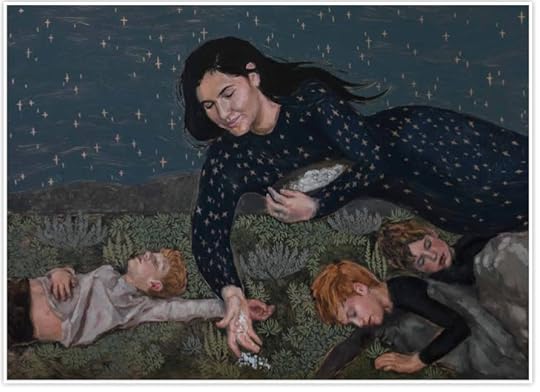 Brooke Bowen, “Heavenly Mother Feeding Manna to Her Children”
Brooke Bowen, “Heavenly Mother Feeding Manna to Her Children”Additionally, destruction is inherent in creation. Sometimes we have to destroy who we are or where we are to create again. This is common in nature: the shell around a seed has to die before it can be grow a new tree. A baby chick has to break the shell in order to begin her life. What do we need to break or let die? I can think of systems that need breaking and habits I need to let die. It’s an interesting thought to consider.
I listened to a podcast recently with Diana Chapman. She talked about how she and her husband had to face that their marriage was dead, and then decide if they wanted to begin again in that framework or change to something different. Three times they went through this process of destruction and creation— and are still happily, passionately married. But they had to choose to create anew.
The greatest creation we will ever do is our own life. We decide what we want it to be filled with and, in turn, who we become.
Heavenly Mother can be involved in that process as well. According to President Harold B. Lee in “The Influence and Responsibility of Women,” Relief Society Magazine 51, no. 2 (Feb. 1964), a friend of his was making a decision to continue an addiction… and then he felt a voice like a mother’s calling him by name— and telling him to cut it out.
And, of course, it makes sense.
“Do you think our Heavenly Parents want us to succeed? Yes! They want us to succeed gloriously! And do you think They will help us? Absolutely!”
President Jean B. Bingham, How Vast Is Our Purpose, May 2017
If you knew you could reach your Heavenly Mother and that She would help you, would that change anything for you?
I get asked a lot about how to reach Her when President Hinckley has advised that we don’t pray to Her. I think She is a god and that means She is infinite with infinite touch points. For me, I feel Her when I create. I have friends who feel Her when they are in nature, when they whip up delicious meals, or when they are supporting their sisterhood. Whatever way you reach to Her, there is a place to meet you.
“On a particularly difficult day—or sometimes a series of difficult days—what would this world’s inhabitants not pay to know that heavenly parents are reaching across those same streams and mountains and deserts, anxious to hold them close?”
Elder Jeffrey R. Holland, Belonging: A View of Membership, April 1980
I am coming into a new season in my life. I have significant decisions to make about the life I am creating. This is true for all of us, always. Today, I am so very grateful to know more of my Heavenly Mother: knowledge that is a star for who I want to become.
November 10, 2021
Stolen Sisters
Clothed in the power of European masculinity and authority, Amerigo Vespucci stands on the shore facing a reclining Indigenous woman. In one hand he holds a brass mariner’s astrolabe; in his other, a crucifix. When Vespucci calls her name, America rises from her bed, hand outstretched, legs slightly parted. Wearing only a headdress and feathered skirt, she eagerly invites Europe’s civilizing presence. Ignoring her cannibalistic tribe in the background, she welcomes conquest. If she resists, the sword and cross Vespucci carries endow him with the military, religious, and political ability to take by force what she withholds.

“The Discovery of America” by Theodor Galle after Jan van der Straet, 1580 image in public domain
That Jan van der Straet drew America as a woman was no accident. That Theodor Galle likewise engraved the same image speaks to the seemingly naturalness of the representation. Sherry Ortner asserts, “…various aspects of woman’s situation (physical, social, psychological) contribute to her being seen as closer to nature, while the view of her as closer to nature is in turn embodied in institutional forms that reproduce her situation” (Is Female to Male as Nature is to Culture?). In the image, Indigenous woman, and by extension the land, willingly receives Vespucci’s male/cultural advances. As the colonizer sows his seeds in a new land, so he claims the women he finds there. European colonizers created a new mythos of Indigeneity intrinsically linked to virginal land ripe for conquest by “civilized” men. They did not step into nativism: they exploited and dominated it.
In Galle’s engraving we see the initial positioning of Indigenous femininity by the colonizing white gaze. This positioning has led to increased rates of violence against Indigenous women and girls. More than half (56.1 percent) of American Indian and Alaska Native (AI/AN) women will experience sexual violence in their lifetime. More than 1 in 7 AI/AN women have experienced sexual violence in the past year. At least, we think so. Sussing out the data challenges even the most stalwart statistician. The National Crime Victimization Survey (NCVS) has only four racial categories, relegating AI/AN, Native Hawaiians, Asian, Pacific Islanders, and mixed race people to the nebulous zone of “Other,” making self-reported rates of violence only nominally valuable when analyzing risk factors for AI/AN. The Department of Justice also collects data, but their responsiveness is dismal. In 2016, 5,712 Indigenous women and girls were reported missing. The DOJ logged only 116 of them in its federal missing persons database. The system, it seems, has failed us.

REDress Project by Jaime Black
But Indigenous communities are not going gently into that goodnight, nor are they passively waiting for justice. They are actively, vociferously fighting to move the needle toward equity. You only have to google #MMIW, #MMIWG, #MMIWG2S, or #MMIWQT to see some of the thousands of ways they’re raising consciousness and advocating for change. Jaime Black’s (Anishinaabe) REDress Project is a visceral response to the emptiness of our lives without the women and girls who have been murdered. The MMIWQT Bead Project: Every One, one of a series of engagement pieces by artist Cannula Hanska (enrolled member of the Three Affiliated Tribes of Fort Berthold), uses over 4,000 handmade clay beads created by various communities across US and Canada, to emphasize the real-world cost of violence against Indigenous women, girls, and queer/trans community members.
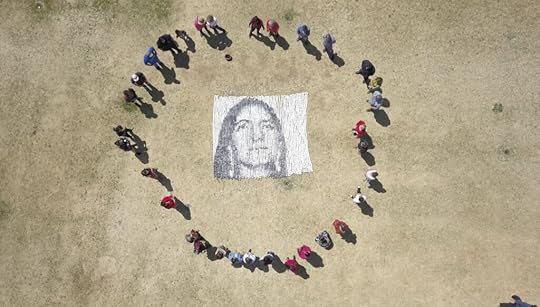
MMIWQT Bead Project (Every One) by Cannula Hanska photo credit: Red Shawl Solidarity Society.
And Fringe by Rebecca Belmore. This piece haunts me. It voices the effects of historic and ongoing genocide, but does so by asserting the modernity and resiliency of Indigenous women. Located at a busy intersection in Quebec in the wake of the Pickton murders, where 49 women were killed, half of whom were Indigenous, the billboard-size photo forces us to confront both the atrocities faced by and the strength of Indigenous communities. The woman in the photo turns her back to us, negates the value of our gaze. With red beads stitching up a wound, Belmore promises that this woman, though hurt, will survive. With her community as a source of healing, she will thrive. She is naked and vulnerable, yes, but also powerful and whole. The needlework, the beadwork, the need for a community of sisters to stitch her up, all speak to a feminine, communal effort.

Fringe by Rebecca Belmore photo credit: Henri Robideau, Guy L’Heureux
“It was the site where they uncovered and openly revealed the depths of their intimate wounds. This confessional aspect served as a healing ritual,” wrote bell hooks in Feminism is for Everybody. We all carry wounds. For some, those wounds have been inflicted through ongoing oppression and the violence of colonization. We have to openly reveal our wounds, to acknowledge the ways we wound each other, before we can begin to stitch each other back up. I believe that, together, if we’re vulnerable and honest, we can bind wounds and heal. We can change the future, so that all women, girls, queer and transgender individuals are safe from violence, but first we have to acknowledge the harm that has been done. It takes effort, and it takes all of us speaking out against all forms of oppression, but I have faith that we can do it.
Featured Image from David Bernie, (Ihanktonwan Dakota Oyate) available here.
November 9, 2021
My Mormon #MeToo Experience and the Language of Consent and Assault
CW: This post discusses experiences with sexual assault and abuse.
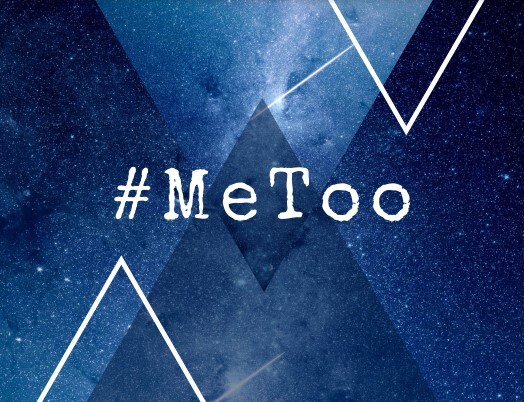
Four years ago, I watched the start of the viral hashtag MeToo on Twitter. At first, it was a trickle, and then a flood of people, mostly women, tweeting about their experiences with sexual assault. The hashtag was soon all over the internet, and it led to action and advocacy off-screen. It brought the necessary momentum to hold some perpetrators accountable for their actions and give a voice to some survivors.
It didn’t happen all at once—it took years—but #MeToo gave me the language to understand and talk about my own experiences with sexual assault.
As a girl raised in the Church of Jesus Christ of Latter-day Saints, I was given a lot of rules around my body and sexuality. Rules on modesty, dating, and chastity. Rules that told me that the existence of my body could be a stumbling block—even walking pornography—to the boys and men around me if I wasn’t careful. Rules that were sometimes vague or confusing (no leader was even clear on the definition of “petting”), and at other times inappropriately explicit (like when one of my bishops at BYU would go into detail about ways that girls masturbated).
But for all the rules, there was little to no talk of consent. There was no talk of grooming, manipulation, or abuse. And there was little sense that I had an immutable worth as a person and daughter of God.
I had my first kiss at a Pop Warner football game when I was twelve years old. It was a fairly simple, chaste kiss with a boy from school. I went home that night with stars in my eyes, thrilled at the experience. The next day in Young Women’s at church, the Beehives (ages 12-13) were combined with the Laurels (ages 16-18). The teacher handed out bookmarks resembling dollar bills with a message about how our kisses are like currency, and the more we give, the less they (and we) are worth. We needed to conserve our kisses so that they (and we) would be worth something to our future husbands. I went home and sobbed for hours. I knew I would not marry that boy, and I knew that I was now worth less (worthless?), and there was no way to reclaim that spent worth.
I knew and loved this leader. I believe she was doing her best with the messages that she had internalized. But this was the first of many lessons that taught me that the Atonement of Jesus Christ was not powerful enough to cover the romantic or sexual experiences of women, consensual or not, sinful or not.
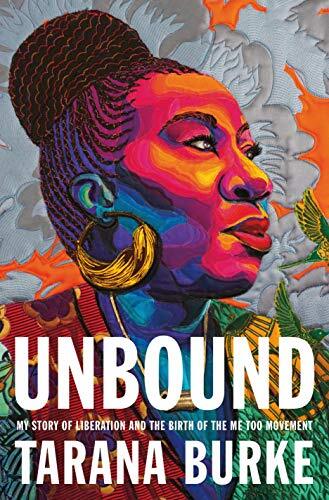
Fast forward to 2017, and #MeToo began trending—a phrase that Tarana Burke had been using for decades in her work as an advocate and activist in creating empathy around experiences of sexual assault. Burke works at the intersection of sexual violence and racial justice, creating movements to bring resources, education, and support for impacted communities. “Me Too” was a way that Burke created space for the mostly black and brown girls in her leadership workshops to talk about the violence in their lives. Her new memoir, Unbound: My Story of Liberation and the Birth of the Me Too Movement, is the breathtaking, heart-wrenching, unflinchingly honest story of her experiences that brought her to this work.
When Burke shares her first experience of being sexually assaulted at age seven, she talks about her fear of being in trouble for all the rules she had broken in the process of her assault—such as “never go off without permission” and “never let anyone touch your private parts.” She was a child and none of this was consensual, but for all the rules she had been given, she hadn’t been taught that if something did happen to her, she was not to blame. Because she interpreted herself to have broken rules in the process of her assault, she believed she was responsible for her abuse. It took many years to consider herself a victim, let alone a survivor, of sexual assault.
I can’t say how many times I had to pause and take a breath while listening to Unbound. Times I had to go back and listen again. Times I wished I had heard these words when I was younger. Like Burke, I was given rules. I did not have an understanding of consent. I did not have a sense of my immutable worth.
 Me at age 18
Me at age 18Like most women, I have many experiences with sexual harassment. But when I was eighteen years old, I was sexually assaulted on multiple occasions by a boyfriend. Because it was not what I would consider rape, I didn’t have the language to talk about my experiences. And because I was a BYU student, I felt unable to report my assault. At the time, if a student reported sexual assault and had broken ANY Honor Code rules in the process, the student could face school and/or church discipline for reporting. For many years, I didn’t tell anyone what I experienced.
#MeToo gave me the language to understand what had happened to me. When in 2020 I started meeting with a therapist, I was finally ready to talk. I first told a close friend, then my therapist, and then my husband. Over months, I told more friends and family members. And the relief that this brought me is hard to understate. I had suffered from the shame and trauma of my assault for fourteen years. But in the months that followed talking about my experience, I felt healing that I didn’t know was possible. After fourteen years, the flashbacks finally stopped. I felt more at home in my body, mind, and spirit. I felt more able to reclaim the immutable worth that had always been mine but had been blocked from me.
The #MeToo movement gave me the language and space to talk about my experiences and work towards healing. But too many survivors of assault do not have the freedom that the movement extended to me and others like me. Burke talks about how as the hashtag flooded the internet, the voices were disproportionately white, cishet women. Too many people of color and LGBTQIA+ individuals do not yet have the support or resources to share their stories. And too often, Nice White Parents work to keep out the educational resources from schools that will give the language and tools for prevention and healing.
It is not enough to give rules to our children and youth. They need education, a robust understanding of consent, and the safety and empathy necessary to talk about abuse and shame to build the resilience necessary to move forward.
For me, the language I gained from the #MeToo movement was liberating. I don’t think that every survivor needs to share the details of their abuse on the internet. But I hope that Burke’s words reach as many people as possible and continue to free those who are not yet free to move out from under shame and into joy.
November 8, 2021
Guest Post: Tell Your Story: Religion and Gender in America
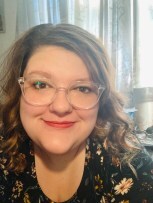
Guest Post by Kate Davis. Kate Davis is a PhD Candidate at Claremont Graduate University. Her research looks at new religious spaces and communities through the lens of feminist theory, with a focus on religions of North America. She currently lives in Ohio with her husband and three cats, where she teaches at several institutions.
I didn’t go to grad school intending to do Mormon Studies. As I think is true for most of us, I could not have predicted the path my grad studies would take. I have pursued an interdisciplinary field of study because I am fascinated by the places where culture and religion intersect, and I sought out a program where I could explore those spaces.
I started my undergraduate work in religion, but soon found that I could not study religion without also studying gender. My quest for knowledge was spurred on by my experience growing up in an Evangelical Christian community. I grew up constantly questioning, feeling pulled between the theology of my religious community and the world of women I saw around me every day, but which never seemed to be accurately represented. The fire and drive for understanding created by my experiences has informed my perspectives as a researcher, beyond just my choice of field. Long after I have left that religious community behind, in my work I still seek to center the lived experiences of women, who are too often the objects rather than subjects of religious narratives.
While doing my coursework I began to take classes which included The Church of Jesus Christ of Latter-day Saints as part of the American religious landscape, and it did not take long for me to fall in love with Mormon Studies. I immediately began to see parallels with the Evangelical traditions I grew up with, and I knew that exploring those connections (and tensions) was what I wanted to do.
Now, as a PhD Candidate in Religion at Claremont Graduate University, I am conducting a study of religious women who are active in online spaces, creating content for platforms like blogs or Instagram. I am particularly interested in interviewing women associated with Evangelical churches and/or groups or women associated with the Church of Jesus Christ of Latter-day Saints. I want to explore how women from these two traditions are using online spaces, both religiously and personally. I have decided to conduct this research through interviews and oral history. I caught the oral history bug from Claudia Bushman, and I was honored to participate in the Oral History Project at CGU. Oral histories are an interactive and creative process, and allow for an equitable and multi-dimensional portrait of the subject. In the introduction to the book Mormon Women Have Their Say: Essays from the Claremont Oral History Collection, Claudia says that “Writing our own stories empowers us […] If we want to live forever in the minds and annals of the earth, if we want other women to be represented into the future, we have to leave a record.” It is my hope that this project will add to that record.
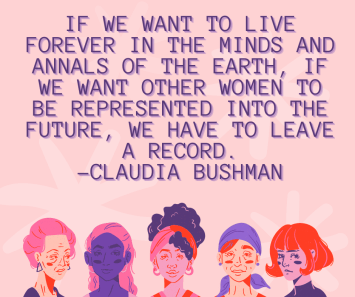
I have been a reader of The Exponent II blog for many years, but as an outside observer rather than a participant. So I am taking this opportunity to introduce myself and, hopefully, find some people who would be willing to sit down with me virtually to talk about their experiences. Participation will include a few things: an informal virtual chat where we can talk about the project and your experiences (this will last approximately 20 to 30 minutes). You can choose to end your participation there, but if you agree to participate in the full study (no pressure!) we will schedule a time for a longer oral history-style virtual interview, which will typically last between 1 and 2 hours. Participation is totally voluntary, and you can stop at any time, or decline to answer any questions without judgment. Oral histories will be archived at CGU, and you can find out more about this project and others like it here.
I would love to hear from anyone, whether you want to participate or would just like to chat about the project, please reach out! Also, if you know of anyone who you think would be interested in participating, please feel free to share my contact information. Here is a form that you can fill out, or you can reach me by email at KateDavisResearch@gmail.com or Kathryn.Sargent@cgu.edu. You can also get in touch with me on Twitter (@katesargedavis) or Instagram (@katesargentdavis).
November 7, 2021
Modern Mormon Women Leaders and the Dearth of Institutional Memory
A few years ago, I was conducting an oral history interview with a Mormon woman from South Africa, now living in the U.S. Samantha’s* life story was fascinating, as she reflected on issues of race in her life and the way she and her community of Cape Coloured people have been disenfranchised in her home country. One especially poignant moment was when she told me the life lessons she’d like to pass on to her children: “That you as a person are enough. You are plenty…. I just hope my children know that being yourself is enough. You don’t have to be anybody else.” Her insistence that her children don’t have to conform to others’ expectations, that they can and should be completely and wholly themselves — so apt given her experience with the systematic dehumanization of people of color — struck me immediately. Her language rang a bell in my mind. It was very similar to that of my favorite Mormon leader, Chieko Okazaki, from the general Relief Society presidency in the 1990s.
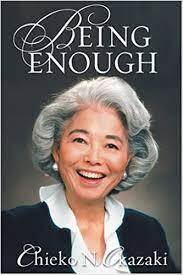 I broke in, “Have you read Being Enough by Chieko Okazaki? She has a whole book dedicated to this idea that we are enough and more than enough as we are.”
I broke in, “Have you read Being Enough by Chieko Okazaki? She has a whole book dedicated to this idea that we are enough and more than enough as we are.”
It was a bit depressing to learn then that not only had Samantha not ever heard of the book, she had not ever even heard of Chieko Okazaki. Samantha was in her thirties and had been raised in the church, but she had never heard of this woman leader who had broached so many topics of importance, like culture, race, and sexual abuse with sensitivity and thoughtfulness.**
This brief exchange weighed on me after our conversation. I left thinking that Samantha would love Chieko’s thoughts. How sad that she and so many women, inside and outside the U.S., don’t know about Chieko and aren’t benefiting from her wisdom. And not only her wisdom. It seems that there is little institutional memory of female church leaders and their contributions since the latter half of the 20th century.
Ever since Belle Spafford was released from the general Relief Society presidency in 1974 after serving for thirty years, terms for general Relief Society presidencies have become shorter, now having stabilized at about five years. It’s difficult to leave a lasting legacy and tackle large projects with a five-year term limit. And, given that there are so few slots for women speakers in General Conference, their most visible venue for speaking and making an impact, it’s no wonder that so many church members don’t have much of a sense of who our women leaders are, what they care about, or even their names.
And this isn’t because our current women leaders aren’t insightful, wise people. It’s because there is a system in place which has weakened women leaders’ influence and ability to connect with their organization members. In our current priesthood-led correlated church, our general Relief Society leaders are no longer designing Relief Society curriculum, as they did during most of the 20th century. They are no longer supervising the publication of a magazine that highlights Relief Society women’s wisdom and thoughts. It’s a rare (and strange) organization which has almost no pathways for its highest leaders to communicate to their members – and for members to communicate to their leaders.***
One thing I would love to see to further bring our women leaders’ voices and insights into people’s consciousness is a newsletter from the Relief Society board and general presidency. It pains me to think of how difficult it is for us women to hold our women leaders up as spiritual authorities, given the dearth of material we have to work with. But if there was a newsletter – monthly, quarterly, electronic, whatever – which highlighted our women leaders’ voices, activities, hopes, personal reflections, and goals, we members would have so much more to work with. We could quote them more often. We could feel more connected to them. We could feel prouder that we belong to this organization because we’d have a sense as to its leaders’ current good works and efforts.
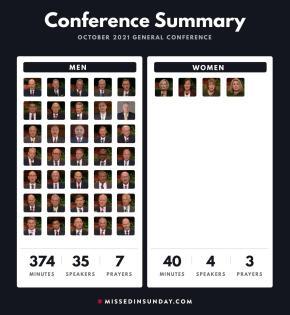 And when we see the depressing graphics of just how little airtime women get in General Conference compared to men, we could at least look forward to a newsletter that forefronts women’s voices and stories. I’d love to see these newsletters translated into dozens of languages, and I’d love to see them feature voices of Relief Society presidents and members from around the world.
And when we see the depressing graphics of just how little airtime women get in General Conference compared to men, we could at least look forward to a newsletter that forefronts women’s voices and stories. I’d love to see these newsletters translated into dozens of languages, and I’d love to see them feature voices of Relief Society presidents and members from around the world.
This change wouldn’t fix systemic problems that routinely sideline women and people of color. But it would be a welcome innovation that easily falls within the current structure.
*Samantha is a pseudonym.
**I imagine that part of the reason Samantha had no knowledge of Chieko Okazaki is due to the fact that church books are not easy to come by outside the U.S. And the reason Chieko Okazaki is such an amazing (potential) spiritual authority and resource is because after her time in the presidency she published over half a dozen books reflecting on gospel principles and her own life.
***General Relief Society presidency members also sometimes write in church magazines, I realize. More of that, please!
November 4, 2021
Guest Post: Why Heavenly Mother is Essential: Part 2
Guest Post by McArthur Krishna, McArthur comes from a pack of storytellers. And while the pack rightly insists she’s only in the running for third-best storyteller on a good day, she’s made her living in stories. Stories in words and visual art that inspire, demand, encourage and cajole us along this wild ride of life. If you know her, she will unabashedly tell your stories too (with some degree of truthiness). Look out.
This is the second of a seven-part series about why Heavenly Mother is essential.
I knew some about Heavenly Mother before I started digging into this topic. I realized She existed. I realized She was the mother of my spirit. I realized I was made in Her image. I assumed she loved me. But some of the other quotes that I found (again from all prophets and apostles) really surprised me.
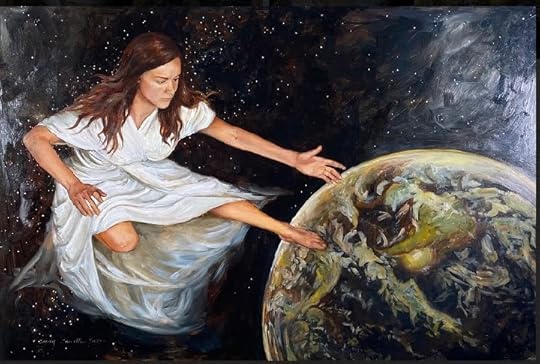 Heavenly Mother Watching Over Her Children by Emily Carruth FullerEssential Fact #2: Heavenly Mother and Heavenly Father both designed the plan of happiness for us… and work together side by side.
Heavenly Mother Watching Over Her Children by Emily Carruth FullerEssential Fact #2: Heavenly Mother and Heavenly Father both designed the plan of happiness for us… and work together side by side. One of the concepts that I didn’t know before is that Heavenly Mother and Heavenly Father both crafted the plan of happiness for our lives. President M. Russell Ballard said, “We are part of a divine plan designed by Heavenly Parents who love us.”
I have a sister-in-law who is a planner. I come from a large family and we all went to their wedding. We showed up to the wedding and had a three-page typed written itinerary down to 15 minute increments. This woman is ON IT. It was a very foreign concept to my family who has a much more roll-with-it kind of approach to time and schedules. Plans for the day are merely suggestions.
She recently called me up and said that it is so satisfying for her to hear about Heavenly Mother.
It hit me— maybe because she didn’t know that when she planned for her family that she’s acting in the model of her Heavenly Mother planning for Her family. What a beautiful thing to think about! In her mind, a talent that she maybe hadn’t quite celebrated before was now realized as something incredibly potent for her.
I started to wonder about other ways that Heavenly Mother and Heavenly Father interact and found a model that was literally life-changing.
First, the doctrine:
No matter to what heights God has attained or may attain, he does not stand alone; for side by side with him, in all her glory, a glory like unto his, stands a companion, the Mother of his children. For as we have a Father in heaven, so also we have a Mother there, a glorified, exalted, ennobled Mother.
Elder Melvin J. Ballard
“The divine Mother, side by side with the divine Father, [has] the equal sharing of equal rights, privileges and responsibilities.”
Susa Young Gates
She is like Him [Heavenly Father] in glory, perfection, compassion, wisdom, and holiness.
Encyclopedia on Mormonism
The divine model is EQUALITY. For the purposes of this posting, we understand we don’t think our Heavenly Parents are exactly the same. They can’t be. But they can have the same divine traits like patience or compassion without being clones.
With that understanding, what shifts?
Working from our most personal spheres to the broader…
How do my identity and goals shift when I know I have the potential to be on par with the supreme power of the universe? How do I talk to myself? How do I spend my time? How do I let others treat me? What roles do I play? Michael Goodman, speaking to women at BYU Women’s Week said, “You are a perfect version of Heavenly Mother. Your destiny is not counselor-hood. Your destiny is Godhood.”
In our families and relationships, do we treat ourselves as equals? As equitable partners? Do we have equal decision-making? Do we have equal access to resources? Do we counsel together? I have seen numerous instances online and from friends and my own life where it was assumed that because the other person in the equation had the priesthood or was male, that they trumped. This is heartbreaking. The Proclamation on the Family calls men and women co-equals… and we need to live like it.
More than anything, women need to see themselves as equa and act like it.
Dr. Jennifer Finlayson-Fife said, “Partnership in marriage does not mean diving up tasks equally. Real partnership in marriage means that equal priority is given to each partner’s needs, wants, and desires and that equal value is given to each partner’s input, time and contribution.”
As Dr. Julie Hanks has said, “It’s not who does what, it’s who decides who does what.”
While these are marriage examples, the same is true for whatever place we find ourselves in. A recent study at BYU divided students into groups of five. Unless four of the five were women, men talked 75% of the time. Most often comments after a women spoke were undercutting or disparaging.
 Her Daughters Divine by Whitney Johnson
Her Daughters Divine by Whitney JohnsonI am not trying to slam men or set up women and men as opponents. Or even say that equality is about speaking up the same amount.
What I am pointing out is that this gender disparity is not just an issue in a far off country in an extreme situation (like the Taliban), and that we as women need to see ourselves as Gods in embryo. This means we claim space for our ideas, and needs, and talents.
What is the impact of a world that begins to follow the divine model of equality? Valerie Hudson’s research shows that countries that follow a divine model of equality literally perform better. This surprised me at first— I thought my visions of equality were perhaps divine-but-fanciful. Turns out, it’s solid. Countries that treat women more equitably have astounding comparative success: lower rates of diseases, higher rates of education, longer life spans, less war.
With this learning it would appear to me that one of the essential concepts we get from Heavenly Mother and Heavenly Father is that working together as equals matters. Let’s try.




